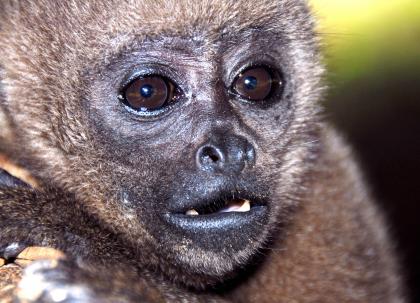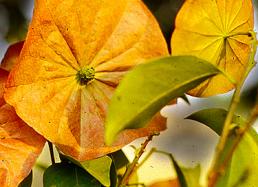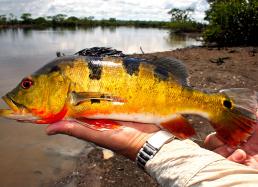7. Camp 3: A 22-kilometer Hike & Abundant Mammals
Saludos from Camp 3, Güeppicillo! We're now in an area actively managed by the Cofan indigenous people. We’ve crossed from one drainage, the Lagartococha, to another drainage, the Güeppí. We did this all on foot—22 kilometers! We covered the distance over three days, walking 11 kilometers, spending a day exploring the midway point, and then walking another 11 kilometers to reach the Güeppicillo stream, a tributary of the Güeppí. We had incredible support from Cofan porters, but I still ended up walking back to carry more of the field gear. Typically we travel with a ton (literally!) of gear (see Photo #1 below.)
Our walk was a fantastic opportunity to experience the large-scale habitat changes between the two drainages. We found several plant species that have never before been registered in Ecuador—including one, a Chaunochiton in the Olacaceae family (see Photo #2 below), which we recorded from only a fruit I picked up off the forest floor during the hike! To see how I normally collect plants, check out my amusing “Video Journal 2: Climbing and Collecting Plants," and to learn how botanists work in the field, take a look at our “Video Report 5: Plants.”
The Gueppicillo camp was along a small blackwater river, right next to a Cofan park guard post. We explored several different habitats here, from a few high terraces with a distinctive root mat, to more sharply eroded hills, to the deeply entrenched streams that dissect them, as well as the frequently flooded bottomlands along the Güeppicillo River. This was the site that exhibited the greatest variation in soils, though we never observed the truly broad variation in sands and clays characteristic of sites in Loreto, Peru, including areas we've visited during other Rapid Biological Inventories.
In our previous two sites, both dominated by blackwater lakes, our ichthyologists documented plentiful game fish, especially the cichlids known as Tucanaré (see Photo #3 below), a prized food for the indigenous residents. Now that we've moved to a habitat dominated by a river, Max and Juan are spending more time in forest streams and are finding some remarkable smaller fishes, including ones that are typically more associated with the Andean foothills. For more information about their work, take a look at their "Video Report 6: Fishes."
What was most remarkable about this site was that the wildlife was abundant and tame, with healthy populations of Woolly Monkeys (one of the favorite foods of the Cofan—see top photo). And this was the only site where we observed the Pygmy Marmoset (Cebuella pygmaea), a tiny and rarely seen primate. The Cofan are clearly doing a great job managing this area. To learn more, check out our mammologist Adriana Bravo’s “Video Report 9: Mammals.”
In a straight line, our camp was 7.5 kilometers from the Peru-Ecuador border. Tomorrow we officially cross into Peru, traveling by boat to our fourth and fifth camps.
Corine
Written October 19, 2007






